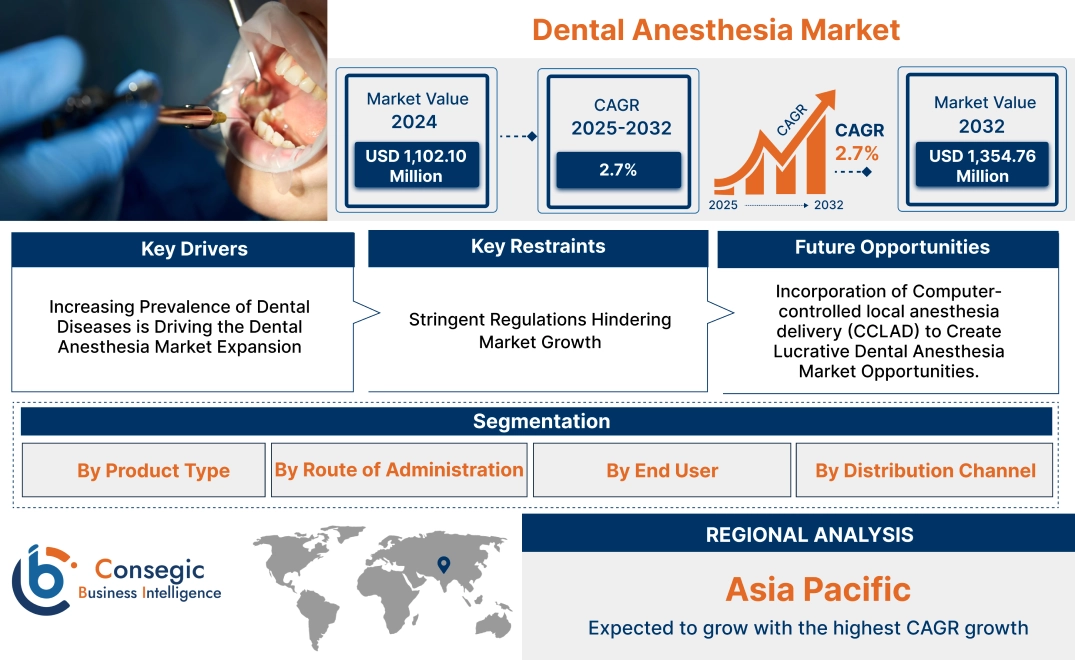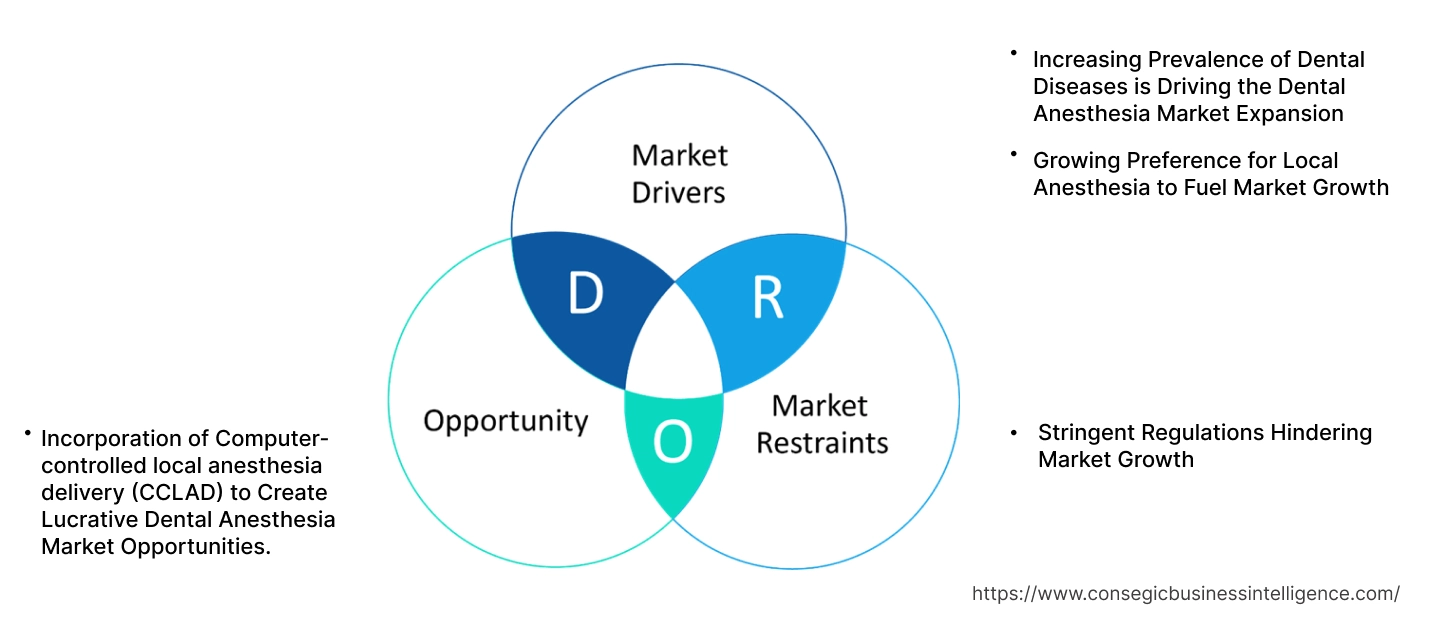- Summary
- Table Of Content
- Methodology
Dental Anesthesia Market Size:
Dental Anesthesia Market size is growing with a CAGR of 2.7% during the forecast period (2025-2032), and the market is projected to be valued at USD 1,354.76 Million by 2032 from USD 1,102.10 Million in 2024.
Dental Anesthesia Market Scope & Overview:
Dental anesthesia aims at managing pain and anxiety during dental procedures. It involves the administration of medications to either numb specific areas of the mouth or induce a state of relaxation or unconsciousness in the patient. The dental anesthesia market growth is driven by several factors such as rising prevalence of dental diseases, growing preference for local anesthesia, amongst others. The market includes a range of anesthetic options, including local anesthesia and general anesthesia. Local anesthesia, involving the injection of medications to numb specific areas, remains the most widely used. General anesthesia, while less common, is utilized for complex procedures or patients with severe anxiety. The global market is expected to experience substantial development in the coming years, driven by the increasing demand for high-quality, patient-centered dental care.
Key Drivers:
Increasing Prevalence of Dental Diseases is Driving the Dental Anesthesia Market Expansion
The increasing prevalence of dental diseases, such as tooth decay, gum disease, and oral infections, is a key driver boosting the dental anesthesia market expansion. As the incidence of these conditions rises, the requirement for effective pain management during dental procedures increases significantly.
For Instance,
- In 2024, According to the World Health Organization (WHO), oral diseases affect nearly 3.5 billion people globally. The most common types of oral diseases include dental caries (tooth decay), periodontal diseases (gum diseases), tooth loss, and oral cancers.
Dental anesthesia plays a crucial role in enabling successful and comfortable dental treatments. By effectively managing pain and anxiety, it allows dentists to perform a wider range of procedures, from routine check-ups to complex surgeries, with greater ease and precision. In conclusion, the rising prevalence of dental diseases is a major driving force behind the expanding market.
Growing Preference for Local Anesthesia to Fuel Market Growth
The growing preference for local anesthesia is a key driver of expansion within the market. Patients increasingly favor this approach due to its simplicity, rapid recovery time, and minimal side effects compared to general anesthesia. Local anesthesia's versatility enhances its appeal, as it is suitable for a wide variety of dental procedures, from routine check-ups and fillings to more complex surgeries like extractions and root canals. Moreover, its cost-effectiveness compared to general anesthesia makes it an attractive option for both patients and healthcare providers.
For instance, in 2023, according to a study published by Science Direct, 87% of patients who underwent surgery including any dental procedure under local anesthesia would prefer local anesthesia if they had the same surgery.
By effectively managing pain and anxiety, local anesthesia enhances patient comfort, improves treatment outcomes, and allows dentists to perform procedures with greater precision and efficiency. This leads to increased patient satisfaction and a more streamlined workflow for dental professionals, further solidifying the role of local anesthesia in driving the development of the market.
Key Restraints:
Stringent Regulations Hindering Market Growth
Stringent regulatory approvals pose a significant hurdle in the development and commercialization of new dental anesthesia medications and delivery systems. Regulatory bodies, such as the Food and Drug Administration (FDA) in the United States, have established rigorous standards for safety and efficacy. This necessitates extensive pre-clinical and clinical trials, involving rigorous testing and data collection to demonstrate the safety, efficacy, and intended use of the product. Traversing this rigorous approval process is time-consuming. This prolonged timeline delays the introduction of new and potentially improved anesthetics to the market, hindering innovation and access to the latest advancements for both patients and healthcare providers.
Furthermore, the extensive research, development, and testing required to meet regulatory standards significantly increases the financial burden on pharmaceutical companies and research institutions. These high development costs limit the development of new and improved anesthesia options, potentially stifling progress in the field. In conclusion, the stringent regulatory landscape poses a significant barrier to the development and commercialization of new dental anesthesia technologies.
Future Opportunities :
Incorporation of Computer-controlled local anesthesia delivery (CCLAD) to Create Lucrative Dental Anesthesia Market Opportunities.
Computer-controlled local anesthesia delivery (CCLAD) enhances patient comfort by minimizing pain and discomfort associated with traditional anesthesia injections. This is particularly beneficial for anxious patients, children, and individuals with low pain tolerance, making dental procedures more tolerable for a wider range of individuals.
Additionally, reduced pain and anxiety translate to increased patient cooperation during dental procedures. This allows for more efficient and effective treatments, potentially shortening procedure times and improving treatment outcomes. Furthermore, CCLAD systems expand the patient base for dental practices. By addressing the concerns of patients who fear dental procedures due to pain and discomfort, these systems attract new patients who have previously avoided necessary dental care.
- For Instance, in 2024, According to studies published PubMedv has shown the efficacy of computer-controlled local anesthesia delivery (CCLAD) as a painless dental anesthesia solution
In conclusion, based on the market analysis, CCLAD systems represent a significant advancement in dental anesthesia, offering numerous dental anesthesia market opportunities. By enhancing patient comfort, improving treatment outcomes, and providing a competitive advantage for dental practices, CCLAD technology is poised to play a crucial role in driving the future of dental anesthesia.
Dental Anesthesia Market Segmental Analysis :
By Product Type:
Based on product type, the market is categorized into Local Anesthesia and General Anesthesia.
Trends in the Product Type:
- The increasing preference for minimally invasive procedures, such as laser dentistry, further fuels the requirement for effective and precise local anesthesia.
- Ongoing research and development are focused on developing safer and more predictable general anesthesia agents with faster recovery times and reduced side effects.
The Local Anesthesia segment accounted for the largest market share in 2024.
- In dentistry, local anesthesia refers to the use of medications to temporarily numb a specific area of the mouth. This allows dentists to perform various procedures, such as fillings, extractions, and root canals, without causing pain to the patient. Local Anesthesia is further classified into Lidocaine, Articaine, Mepivacaine, Prilocaine and Others
- Local anesthesia offers significant advantages for patients. It provides effective pain control while allowing patients to remain conscious throughout the procedure, reducing anxiety and minimizing the risk of complications associated with general anesthesia.
- Furthermore, local anesthesia typically has a rapid onset of action and a short recovery time, allowing patients to resume their normal activities quickly after the procedure.
- Moreover, local anesthesia is highly suitable for a wide range of dental procedures, from simple fillings and extractions to more complex surgeries. This broad applicability makes it an indispensable tool for dentists in their daily practice.
- For Instance, in 2021, according to PubMed, articaine was the first-line local dental anesthetic agent in Germany with a significant market share of roughly 98%.
- In conclusion, based on the market analysis, the aforementioned factors make local anesthesia the dominant segment in the global dental anesthesia market demand.
The General Anesthesia segment is expected to grow at the fastest CAGR over the forecast period.
- In dentistry, general anesthesia refers to the administration of medications that cause the patient to lose consciousness during dental procedures.
- The rise in requirement for complex surgeries, such as implant placements, oral and maxillofacial surgeries, and extensive reconstructive procedures, necessitates the use of general anesthesia to ensure patient safety and optimal treatment outcomes.
- Additionally, the aging population is experiencing an increased prevalence of complex dental issues, such as oral cancer and periodontal diseases, requiring more extensive surgical interventions that mainly necessitate general anesthesia.
- Advancements in anesthesia techniques, such as the development of safer and more predictable anesthetic agents and the integration of advanced monitoring technologies, are also contributing to the development of the general anesthesia segment. These advancements enhance patient safety and improve overall experience, making general anesthesia a more viable option for a wider range of patients.
- Hence, due to the above-mentioned factors, it is important to note that while general anesthesia is expected to exhibit dental anesthesia market trends.
By Route of Administration:
The route of administration segment is categorized into injection, creams, gels and spray
Trends in the Route of Administration:
- The development of longer-lasting injectable anesthetics is reducing the need for multiple injections, improving patient comfort and enhancing treatment efficiency.
- Creams and gels are increasingly used in pediatric dentistry to numb the oral mucosa before injections, reducing anxiety and improving patient cooperation.
The Injections segment accounted for the largest market share of 45.12% in 2024.
- Injection-based anesthesia currently dominates the dental anesthesia market demand due to its high efficacy and widespread use in various dental procedures. This dominance is further reinforced by several key trends.
- The significant advancements are being made in delivery systems. The integration of technologies like computer-guided anesthesia (CGA) and the utilization of smaller needles aim to improve the accuracy and precision of injections, minimizing discomfort and the risk of complications for patients.
- Additionally, the development of longer-lasting injectable anesthetics is a major focus. These advancements reduce the need for multiple injections, enhance patient comfort and improve treatment efficiency by minimizing discomfort and reducing procedure time.
- For Instance, in 2024, Hikma launches Midazolam Injection, USP, in a prefilled syringe in the US. Midazolam that is also used in general anesthesia should be used only in hospital or ambulatory care settings, including physicians and dental offices
- Hence, the injection segment withing the global market is currently dominating and is expected to continue its dominance over the forecast period
The Gels segment is expected to grow at the fastest CAGR over the forecast period.
- Dental gels offer a relatively painless and less traumatic method of administering anesthesia compared to injections, particularly for anxious patients, especially children. This minimizes patient distress and enhances the overall treatment experience.
- Additionally, the increasing popularity of minimally invasive procedures, such as laser dentistry, further fuels the development of the gels segment. These procedures mainly require localized anesthesia, and dental gels provide a convenient and effective method for achieving the desired level of numbness.
- Moreover, ongoing research and development are focused on improving the efficacy and duration of action of dental gels. Newer formulations offer faster onset of action, longer-lasting numbness, and improved patient comfort, making them increasingly attractive for both patients and dental professionals.
- These factors collectively contribute to the projected rapid development of the dental gels segment within the market.
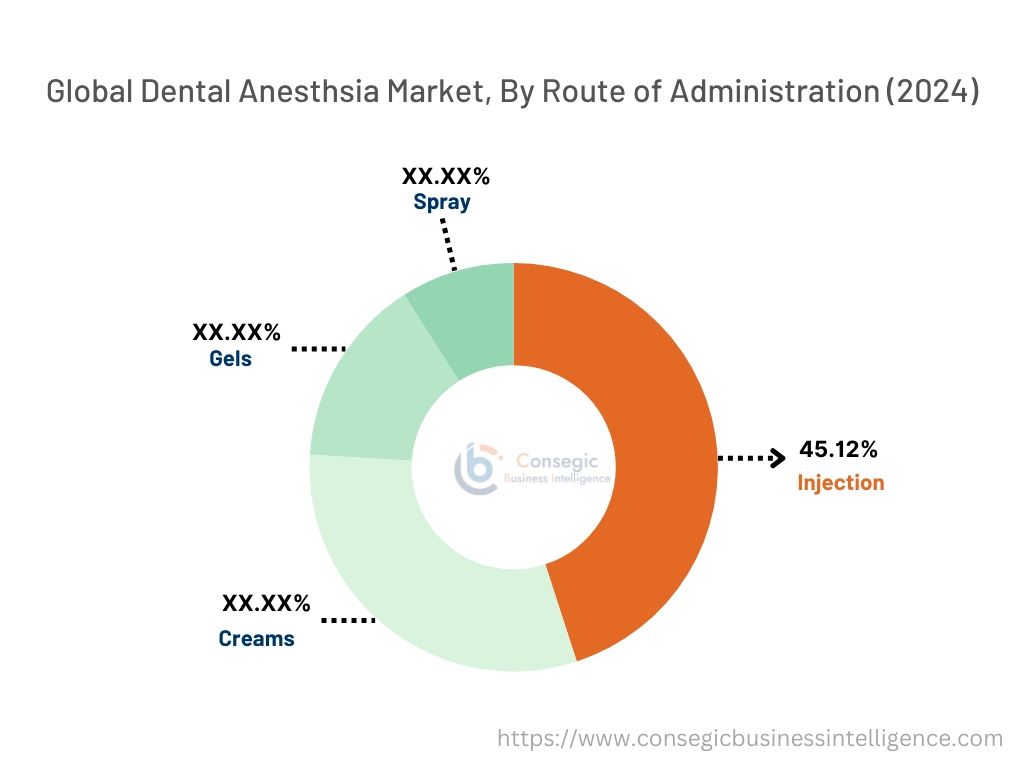
By End-User:
The end user segment is categorized into dental clinics, hospitals and others
Trends in the End User:
- Dental clinics are increasingly focusing on enhancing patient comfort and experience, leading to a higher requirement for effective and patient-friendly anesthesia options.
- Hospitals catering to complex procedures, such as oral and maxillofacial surgeries, that require advanced anesthesia techniques
The Dental Clinics segment accounted for the largest market share in 2024.
- The dental clinics segment currently dominates the market, driven by the high volume of routine dental procedures performed in these settings.
- The development of private dental practices is a significant contributor to this dominance, fueled by factors such as the expanding middle class, increased awareness of oral health, and advancements in dental technology.
- Furthermore, dental clinics are increasingly prioritizing patient comfort and experience. This focus on pain management, enhanced patient communication, and the creation of a welcoming environment is crucial for attracting and retaining patients, driving the requirement for effective and patient-friendly anesthesia options.
- For instance, in 2023, according to American Dental Association (ADA), U.S. Census Bureau, County Business Patterns, there were 135,333 dental clinics establishments in the U.S.
- These factors collectively contribute to the significant role of dental clinics in driving the dental anesthesia market trends.
The Hospitals segment is expected to grow at the fastest CAGR over the forecast period.
- The hospitals segment is primarily driven by the increasing requirement for complex dental procedures. Procedures such as oral and maxillofacial surgeries, implant placements, and extensive reconstructive procedures often require the expertise of anesthesiologists and access to advanced monitoring equipment typically found in hospital settings.
- Furthermore, hospitals prioritize patient safety and have robust infrastructure and protocols for managing potential complications associated with anesthesia. This emphasis on patient safety ensures a high level of care during and after complex dental procedures, contributing to the growing reliance on hospital settings for such interventions.
- Hospitals lead the way in adopting and implementing the latest advancements, such as computer-guided anesthesia, advanced monitoring systems, and the use of newer, safer anesthetic agents.
- These technological advancements enhance patient safety and improve the overall efficacy of anesthesia, further solidifying the role of hospitals in the market.
- These factors collectively indicate that the hospitals segment is poised for significant development within the market, driven by the increasing requirement for complex procedures, advancements in technology, and the focus on patient safety and specialized care.
By Distribution Channel:
The distribution channel segment is categorized into direct sales, retail pharmacies, hospital pharmacies and online pharmacies
Trends in the Distribution Channel:
- Direct sales allow for customized solutions, such as bulk orders and tailored product offerings, to meet the specific needs of individual healthcare providers.
- Hospital pharmacies play a crucial role in the distribution of anesthetics used in hospital-based dental procedures, ensuring timely and accurate medication delivery.
The Direct Sales segment accounted for the largest market share of 2024.
- Direct sales enable manufacturers to establish and maintain strong relationships with key customers, such as dental clinics, hospitals, and oral surgery centers. These relationships facilitate direct communication, personalized service, and timely delivery of products. Manufacturers effectively address customer needs and concerns, provide valuable insights into product usage, and offer customized solutions tailored to individual requirements.
- Additionally, direct sales provide manufacturers with greater control over the distribution and marketing of their products. This ensures the quality and integrity of their products throughout the supply chain, minimizing the risk of counterfeit or substandard products entering the market.
- Furthermore, direct sales enable manufacturers to engage in targeted marketing and sales efforts. This allows them to tailor their messages and promotional activities to the specific needs and preferences of different customer segments within the dental market, maximizing the effectiveness of their marketing campaigns.
- Moreover, direct sales channels allow manufacturers to provide valuable technical support and training to healthcare professionals on the proper use and handling of their anesthesia products. This ensures that healthcare providers are well-equipped to administer anesthesia safely and effectively, ultimately improving patient outcomes.
- These factors collectively contribute to the dominance of the direct sales channel in the market, ensuring efficient product distribution, strong customer relationships, and effective market penetration for manufacturers.
The Online Pharmacies segment is expected to grow at the fastest CAGR over the forecast period.
- The rapid growth of e-commerce across various industries, including healthcare, has significantly increased consumer acceptance of online medication purchases. This trend, combined with the growing requirement for convenience and accessibility, has driven consumers towards online pharmacies, allowing them to order medications from the comfort of their homes and have them delivered directly to their doorstep.
- Furthermore, online pharmacies often provide greater transparency in pricing and allow customers to easily compare prices from different vendors. This increased price transparency empowers consumers to make informed decisions and find the most cost-effective options for their dental anesthesia needs.
- Advancements in technology, such as secure online payment gateways and robust online pharmacy platforms, have significantly enhanced the safety and reliability of online medication purchases, addressing concerns regarding the security and authenticity of products.
- Additionally, online pharmacies are expanding their product offerings to include a wider range of dental anesthetics and related products, making them a more attractive option for both patients and healthcare providers.
- For instance, in 2022, according to IBEF, There are currently close to 50 e-pharmacies in India and are expected to increase at a compounded annual rate of 44% over the upcoming years
- Based on the dental anesthesia market analysis, these factors collectively contribute to the rapid development of the online pharmacy segment within the market. While regulatory considerations and varying legal frameworks across different countries pose barriers, the convenience, accessibility, and growing consumer acceptance of online platforms are expected to drive significant development in this segment in the coming years.
Regional Analysis:
The regional segment includes North America, Europe, Asia Pacific, the Middle East and Africa, and Latin America.
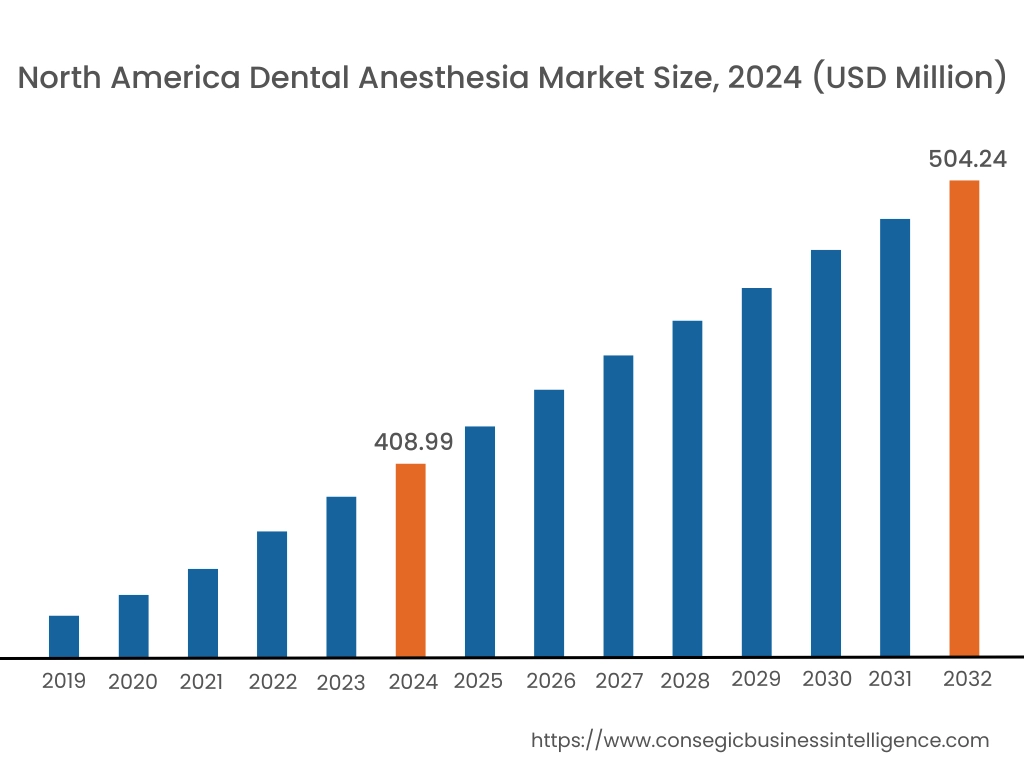
In 2024, North America accounted for the highest dental anesthesia market share at 37.11% and was valued at USD 408.99 Million and is expected to reach USD 504.24 Million in 2032. In North America, U.S. accounted for the dental anesthesia market share of 72.75% during the base year of 2024. North America dominates the market. North America boasts a highly developed healthcare infrastructure with significant investments in dental care, translating to high healthcare expenditure and increased access to dental services. This robust healthcare infrastructure, equipped with advanced facilities, skilled healthcare professionals, and cutting-edge technology, facilitates the adoption and implementation of advanced anesthesia techniques and ensures the availability of a wide range of anesthesia options.
- For instance, According to American Dental Association (ADA), national dental spending increased by 2.5% from 2022 to 2023.
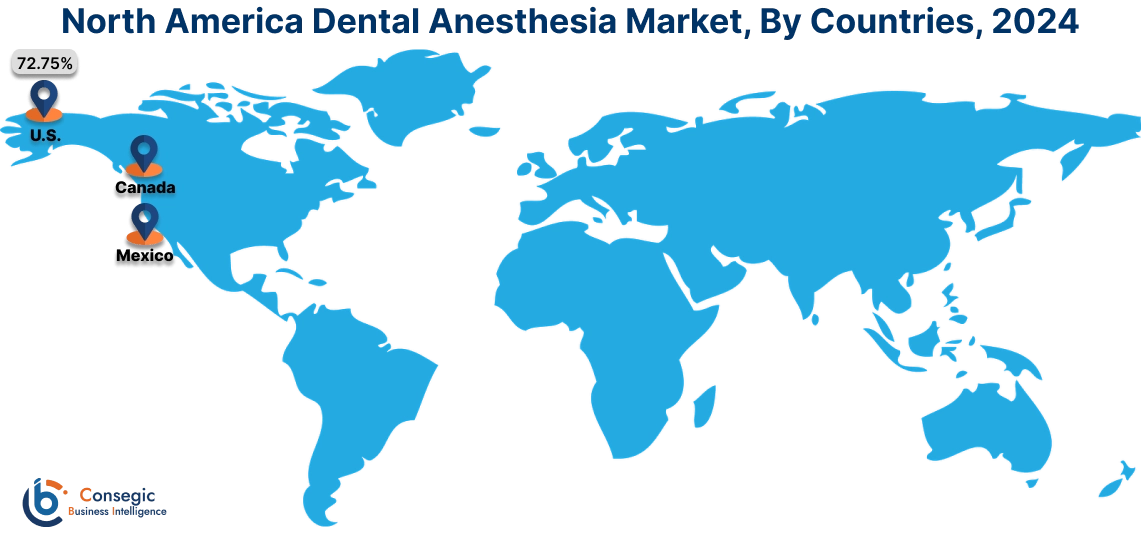
Additionally, based on the dental anesthesia market analysis, the strong presence of key pharmaceutical companies and medical device manufacturers specializing in dental anesthesia within North America fosters innovation and drives research and development in this field. These factors collectively contribute to the dominance of the North American region in the market.
In Asia Pacific, the dental anesthesia industry is experiencing the fastest growth with a CAGR of 3.3% over the forecast period. The region is experiencing rapid economic growth, leading to increased disposable incomes and improved access to healthcare services, including dental care. This, coupled with increased demand for high-quality healthcare and a greater willingness to invest in oral health is expected to have a positive impact on the market. Furthermore, the rising prevalence of dental diseases, such as tooth decay and periodontal diseases, across the region is creating a significant demand for dental treatments and, consequently, for anesthesia services. Additionally, based on the market analysis, the growing awareness of the importance of oral health and its impact on overall well-being is driving greater utilization of dental services, including those that require anesthesia. Finally, the region's favorable demographics, with a large and growing population, particularly within the working-age group, further fuel the requirement for dental care and anesthesia services. These factors collectively contribute to the rapid growth of the market within the Asia-Pacific region.
The European market for dental anesthesia is characterized by a mature healthcare system with a strong emphasis on patient safety and quality of care. This well-established system, with its advanced facilities, such as well-equipped hospitals and dental clinics, and a highly skilled workforce of dental professionals, provides a robust foundation for the market. The presence of strong research and development infrastructure within Europe fosters innovation in anesthesia technologies. This leads to the development of new and improved anesthetic agents with potentially longer durations of action and reduced side effects, as well as innovative delivery systems, such as computer-guided anesthesia, that enhance accuracy and minimize discomfort. Additionally, as per the market analysis, advancements in pain management techniques, including the use of multimodal anesthesia approaches, contribute to improved patient outcomes and drive the dental anesthesia market growth within the European region.
The Middle East and Africa region is experiencing significant development in the market, driven by a combination of economic and demographic factors. Rapid economic development across many countries in this region has led to increased disposable incomes and improved access to healthcare services, including dental care. This expanding middle class has a greater disposable income to invest in their health, leading to increased demand for dental treatments and, consequently, for anesthesia services. Furthermore, rising awareness of the importance of oral health and its impact on overall well-being is driving greater utilization of dental services, including those that require anesthesia. However, the market within this region is characterized by significant diversity, with varying levels of healthcare infrastructure, economic development, and access to quality dental care across different countries. This diversity presents both challenges and opportunities, requiring tailored approaches to meet the specific needs of each market segment.
The Latin American market for dental anesthesia is showing significant development potential, driven by a combination of economic and demographic factors. The region is experiencing a rise in disposable incomes and a growing middle class, leading to increased demand for high-quality healthcare services, including dental care. This expanding middle class has a greater disposable income to invest in their health, driving requirement for dental procedures and, consequently, for anesthesia services. However, the Latin American market also faces challenges such as varying levels of healthcare infrastructure and access to quality dental care across different countries. Overcoming these disparities in healthcare access is crucial for ensuring equitable access to safe and effective anesthesia services throughout the region.
Top Key Players and Market Share Insights:
The global Dental Anesthesia Market is highly competitive with major players providing products to the national and international markets. Key players are adopting several strategies in research and development (R&D) and product innovation to hold a strong position in the global dental anesthesia market. Key players in the dental anesthesia industry include-
- Dentsply Sirona (U.S.)
- Laboratorios Inibsa (Spain)
- Dentalhitec (France)
- Zeyco (U.S.)
- Pierre Pharma (France)
- Septodont (France)
- Laboratorios Normon (Spain)
- Primex Pharmaceuticals (Switzerland)
- Aspen Group (U.S.)
Dental Anesthesia Market Report Insights :
| Report Attributes | Report Details |
| Study Timeline | 2019-2032 |
| Market Size in 2032 | USD 1,354.76 Million |
| CAGR (2025-2032) | 2.7% |
| By Product Type |
|
| By Route of Administration |
|
| By End-User |
|
| By Distribution Channel |
|
| By Region |
|
| Key Players |
|
| North America | U.S. Canada Mexico |
| Europe | U.K. Germany France Spain Italy Russia Benelux Rest of Europe |
| APAC | China South Korea Japan India Australia ASEAN Rest of Asia-Pacific |
| Middle East and Africa | GCC Turkey South Africa Rest of MEA |
| LATAM | Brazil Argentina Chile Rest of LATAM |
| Report Coverage |
|
Key Questions Answered in the Report
How big is the Dental Anesthesia Market? +
In 2024, the Dental Anesthesia Market is USD 1,102.10 Million.
Which is the fastest-growing region in the Dental Anesthesia Market? +
Asia Pacific is the fastest-growing region in the Dental Anesthesia Market.
What specific segmentation details are covered in the Dental Anesthesia Market? +
Product Type, Route of Administration, End-User and Distribution Channel segmentation details are covered in the Dental Anesthesia Market
Who are the major players in the Dental Anesthesia Market? +
Dentsply Sirona (U.S.), Laboratorios Inibsa (Spain), Pierre Pharma (France), Septodont (France), Laboratorios Normon (Spain), Primex Pharmaceuticals (Switzerland), Aspen Group (U.S.), Dentalhitec (France), and Zeyco (U.S.).
